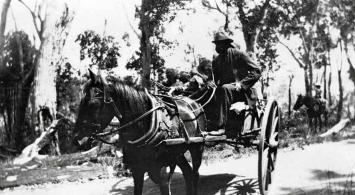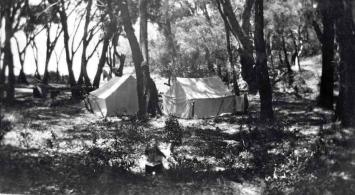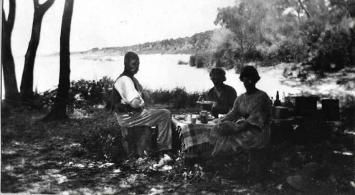Dutch sailors sight the coast in 1622 and name it 't Landt van de Leeuwin' —the land of the lioness.In 1801 a scientific expedition under the command of Captain Nicolas Baudin and Commander Emmanuel Hamelin visited Geographe Bay in the corvettes (small warships) ‘Geographe’ and ‘Naturaliste’. After making landfall at Cape Leeuwin on 27th May 1801, the ships travelled up the coast and into Geographe Bay to study the natural resources in the area.
On May 30th that year a party unsuccessfully look for water at Eagle Bay. They had then been away from home for three years. Many places along the coastline are named in honour of that journey. There were no instructions from the French government to claim any land in the name of France.
Local residents Brian and MargaretWinchcombe initiated the Baudin memorial (pictured below) to commemorate the landing of the Baudin party at Eagle Bay in 1801. The memorial was built by the Shire of Busselton and unveiled in June 2001 before 600 people.
 It took until 1830’s until the area was settled. With the settlement of the British Swan River Colony around Perth in 1829 by Captain James Stirling, it was soon realised that much of the land around the colony was unsuitable for agriculture. The colony expanded beyond the Swan River and into the southwest in the 1830’s. Land for a townsite at Dunsborough (Dunsbro) was set aside in the 1830's. “The Fishery” at Castle Bay was one of the first settlements in the area. “The Fishery” was set up by the Castle Bay Whaling company to bring in and process whales. A small fish processing factory operated in Eagle Bay during the 1950's to process Australian Salmon caught by a commercial fishery, the ‘Eagle Bay Syndicate’.
It took until 1830’s until the area was settled. With the settlement of the British Swan River Colony around Perth in 1829 by Captain James Stirling, it was soon realised that much of the land around the colony was unsuitable for agriculture. The colony expanded beyond the Swan River and into the southwest in the 1830’s. Land for a townsite at Dunsborough (Dunsbro) was set aside in the 1830's. “The Fishery” at Castle Bay was one of the first settlements in the area. “The Fishery” was set up by the Castle Bay Whaling company to bring in and process whales. A small fish processing factory operated in Eagle Bay during the 1950's to process Australian Salmon caught by a commercial fishery, the ‘Eagle Bay Syndicate’.
Dunsborough townsite was gazetted in 1879, with only a few shacks in the area until the 1900s.
At Cattle cove, where the coastal track joins the beach between Dunsborough and Castle Rock, cattle were penned and swum out to waiting ships, to be hoisted aboard for shipment.
Inland farmers camped with their families under the trees between Dunsborough and Eagle Bay, escaping the heat of the interior and living off their fishing. Stays could be several weeks, and evidence of extensive camping sites remains. Into the 1960’s Peter and Joy Smith supervised the camping at Meelup and eventually a toilet was built but failing water supply forced the closure of the facility.
For the past 150 years Meelup and nearby beaches have been popular picnic and day-trip destinations for both local and regional residents. Camping at Meelup Beach was permitted until the 1970’s.
Six separate reserves in the area were amalgamated in 1993 to form Meelup Regional Park, a designated a "Class A" reserve vested in the City of Busselton for the purposes of conservation and recreation. A number of small additions were subsequently made, and the reserve now comprises 16 lots. The reserve extends to the low water mark from its southernmost point at Dunsborough to Eagle Bay, and from Eagle Bay to its northernmost point at Bunker Bay the reserve extends to the high water mark.



